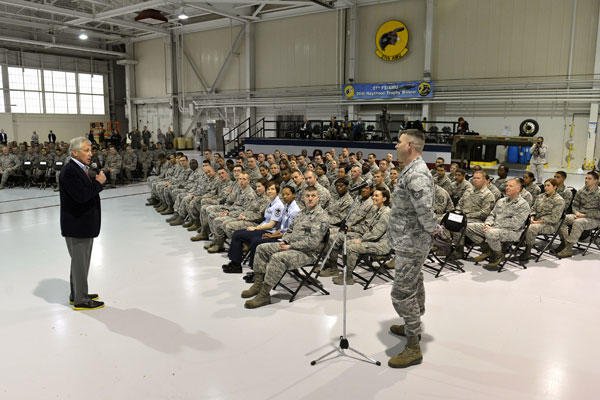Defense Secretary Chuck Hagel met with troops face-to-face Tuesday for the first time since he introduced a defense budget proposal that cuts service members' pay and benefits.
In a town hall meeting with soldiers at Fort Eustis, Va., Hagel said that "what we're proposing we think is fair" to slow the growth of pay and benefits to allow for improvements in readiness and modernization in a smaller force after the wars in Iraq and Afghanistan.
His remarks were greeted respectfully by the soldiers. There was no applause, but the questions put to Hagel were direct and unemotional.
Hagel cited the Basic Allowance for Housing as an example in the Pentagon's first overall effort to pare back benefits in the all-volunteer era of the military.
"You all get 100 percent" in the BAH, Hagel told the troops. "You don't pay anything." In the coming years, troops would be asked to pay five percent of the BAH under the proposals in the Pentagon's Fiscal Year 2015 budget, Hagel said.
Hagel noted that up until the late 1990s, service members paid 18 percent of BAH.
Hagel stressed to the troops that there will be no pay cuts and, in fact, "there will be pay increases." However, the pay raises will not come at the rate troops had come to expect when defense budgets soared after the Sept. 11, 2001, terror attacks.
In another cost-cutting measure, the proposed budget called for merging the current three Tricare Prime, Extra and Standard programs into one.
Hagel said "it just makes sense" that the Tricare proposals also included a "slight, modest increase in co-pays for families and working age retirees" in the range of 8-11 percent that would be worked in gradually.
A sergeant in Hagel's audience asked how the nation would respond with a smaller force "if another war kicks off."
The Pentagon's budget proposal called for shrinking the Army to a range of 440,000 to 450,000. However, Hagel rejected comparing that number to the pre-World War II levels of the force.
"I think that's really a bogus comparison," Hagel said.
Hagel pointed to superior weaponry, technology and firepower available to modern troops. "Look at the capability per person, look at the equipment you have," Hagel said.
"Would we rather have more soldiers than less? Of course, we would," Hagel said, but the budget realities have forced the Pentagon to choose to trim the Army's end strength.
Veterans groups warned that the cuts would hit hard on military families and eventually impact recruiting and retention.
"When you combine the two pay caps [FY14 and FY15] and the 5 percent out-of-pocket housing cut proposal, an E-5 [Army sergeant] with 10 years' service and a family of four will see an annual loss of $1,400," said Norb Ryan, president of the Military Officers Association of America.
"An 0-3 [Army captain] would lose $2,100 by the end of FY2015," Ryan said. "What's unknown is the overall financial impact to members and their families when you add these pay and housing reductions to the proposals to cut back on the commissary benefit and change military health care."
"The truth is these cuts will continue to grow deeper" unless Congress ends the sequester process that has imposed an estimated $500 billion in spending cuts on defense through 2021, said William A. Thien, national commander of the Veterans of Foreign Wars.
"In an all-volunteer force, the troops get a vote," Thien said. "And a resurging economy will impact individual decisions to join and re-enlist."
-- Richard Sisk can be reached at Richard.Sisk@monster.com.































